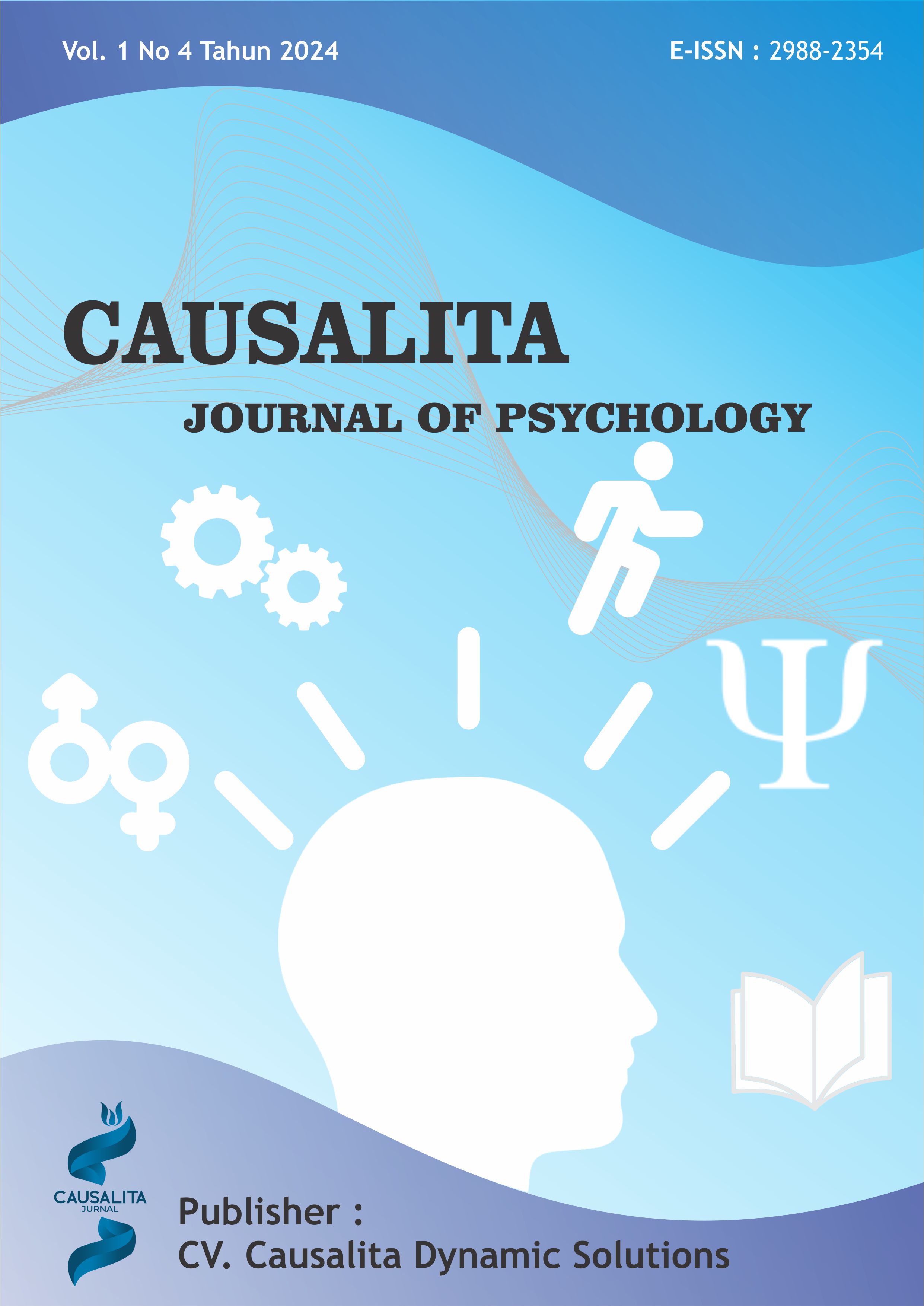HUBUNGAN HARGA DIRI DENGAN PRESENTASI DIRI TIDAK AUTENTIK PADA PENGGUNA INSTAGRAM AKTIF
DOI:
https://doi.org/10.62260/causalita.v1i4.120Keywords:
Harga diri, inauthentic self presentation, InstagramAbstract
Penelitian ini bertujuan untuk mengetahui hubungan yang signifikan antara harga diri dengan presentasi diri tidak autentik (inauthentic self presentation) pada pengguna instagram aktif. Penelitian ini menggunakan metode kuantitatif dengan desain kuantitatif korelasional. Populasi pada penelitian ini yaitu wanita usia 18-25 tahun yang memiliki akun instagram serta pernah mengunggah postingan pada akun instagramnya. Teknik pengambilan sampel pada penelitan ini memakai teknik purposive sampling dengan jumlah 273 orang. Instrumen pada penelitian ini menggunakan skala Self Presentation On Facebook Questionnaire (SPFBQ) oleh Michikyan et al. (2015) yang sudah dimodifikasi oleh peneliti dan mengadaptasi skala State Self Esteem Scale (SESS) oleh Heatherton (1991) yang sudah diterjemahkan dan dimodifikasi oleh Hasanati, ( 2020). Hasil analisis dengan menggunakan analisis data korelasi pearson product moment dan didapatkan koefisien yang berkorelasi (r) = -0,473 dengan nilai signifikasn sebesar = .000 (p<0,05) artinya terdapat hubungan yang negatif signifikan antara harga diri dengan presentasi diri tidak autentik ( inauthentic self presentation )pada pengguna instagram aktif. Harga diri merupakan faktor yang mempengaruhi inauthentic self presentation pada pengguna instagram aktif. Pengguna instagram dengan harga diri yang rendah cenderung melakukan strategi dalam mempresentasikan dirinya di instagram. Harga diri memiliki hubungan negatif yang signifikan dengan inauthentic self presentation , sehingga semakin rendah harga diri pengguna instagram maka semakin tinggi inauthentic self presentation pada pengguna instagram aktif, begitu sebaliknya.
References
Azwar, S. (2018). Metode Penelitian Psikologi (2nd ed.). Pustaka Pelajar.
Bakhshi, S., Shamma, D. A., & Gilbert, E. (2014). Faces engage us: Photos with faces attract more likes and comments on instagram. Conference on Human Factors in Computing Systems - Proceedings, 965–974. https://doi.org/10.1145/2556288.2557403
Ellison, N., Heino, R., & Gibbs, J. (2006). Managing impressions online: Self-presentation processes in the online dating environment. Journal of Computer-Mediated Communication, 11(2), 415–441. https://doi.org/10.1111/j.1083-6101.2006.00020.x
Erdoğmuş, Y., Arslan, D., Hepdoğan, D., & Özbay, Y. (2018). Does Self-Esteem Predict the Authenticity of Self-Presentation on Instagram? KOÇ University Undergraduate Psychology Journal, 6(6), 11–16.
Gil-Or, O., Levi-Belz, Y., & Turel, O. (2015). The “Facebook-self”: Characteristics and Psychological Predictors of False Self-Presentation on Facebook. Frontiers in Psychology, 6(FEB), 1–10. https://doi.org/10.3389/fpsyg.2015.00099
Hasanati, U. (2020). Hubungan Social Comparison Dengan Self-Esteem Pada Dewasa Awal Pengguna Instagram.
Hu, Y., Menikonda, L., & Kambhampati, S. (2017). A First Analysis of Instagram Photo Content and User Types. Frontiers of Mathematics in China, 12(1), 247–260. https://www.aaai.org/ocs/index.php/ICWSM/ICWSM14/paper/view/8118/8087
Kemp, S. (2022). Digital 2022 : Indonesia. Datareportal. https://datareportal.com/reports/digital-2022-indonesia
Krämer, N. C., & Winter, S. (2008). Impression Management 2.0: The Relationship of Self-Esteem, Extraversion, Self-Efficacy, and Self-Presentation Within Social Networking Sites. Journal of Media Psychology, 20(3), 106–116. https://doi.org/10.1027/1864-1105.20.3.106
Mazali, M. (2011). Social Media As A new Public Sphere. 44(3). https://doi.org/https://doi.org/10.1162/LEON_a_00195
Mehdizadeh, S. (2010). Self-Presentation 2.0: Narcissism and Self-Esteem on Facebook. Cyberpsychology, Behavior, And Social Networking, 13(4).
Michener, H. A., Delamater, J. D., & Myers, D. J. (2015). Social Psychology (8th ed.). Boulder: Westview Press.
Michikyan, M., Dennis, J., & Subrahmanyam, K. (2015). Can You Guess Who I Am? Real, Ideal, and False Self-Presentation on Facebook Among Emerging Adults. Emerging Adulthood, 3(1), 55–64. https://doi.org/10.1177/2167696814532442
Pittman, M., & Reich, B. (2016). Social media and loneliness: Why an Instagram picture may be worth more than a thousand Twitter words. Computers in Human Behavior, 62, 155–167. https://doi.org/10.1016/j.chb.2016.03.084
Salim, F., Rahardjo, W., Tanaya, T., & Qurani, R. (2017). Are Self-Presentation Influenced by Friendship-Contingent Self-Esteem and Fear Of Missing Out? Makara Human Behavior Studies in Asia, 21(2), 70. https://doi.org/10.7454/mssh.v21i2.3502
Sembiring, K. D. R. (2017). Hubungan Antara Kesepian Dan Kecenderungan Narsisistik Pada Pengguna Jejaring Sosial Media Instagram. Jurnal Psikologi, 16(2), 147. https://doi.org/10.14710/jp.16.2.147-154
Simmons, M., & Lee, J. S. (2020). Catfishing : A Look Into Online Dating and Impersonation.
Tsikerdekis, M., & Zeadally, S. (2015). Detecting and Preventing Online Identity Deception in Social Networking Services. IEEE Internet Computing, 19(3), 41–49. https://doi.org/10.1109/MIC.2015.21
Twomey, C., & O’Reilly, G. (2017). Associations of Self-Presentation on Facebook with Mental Health and Personality Variables: A Systematic Review. Cyberpsychology, Behavior, and Social Networking, 20(10), 587–595. https://doi.org/10.1089/cyber.2017.0247
Wang, P., Xie, X., Wang, X., Wang, X., Zhao, F., Chu, X., Nie, J., & Lei, L. (2018). The need to belong and adolescent authentic self-presentation on SNSs: A moderated mediation model involving FoMO and perceived social support. Personality and Individual Differences, 128(59), 133–138. https://doi.org/10.1016/j.paid.2018.02.035
Wiederhold, B. K. (2018). The Tenuous Relationship between Instagram and Teen Self-Identity. Cyberpsychology, Behavior, and Social Networking, 21(4), 215–216. https://doi.org/10.1089/cyber.2018.29108.bkw
Downloads
Published
Issue
Section
License
Copyright (c) 2024 CAUSALITA : Journal Of Psychology

This work is licensed under a Creative Commons Attribution-ShareAlike 4.0 International License.






